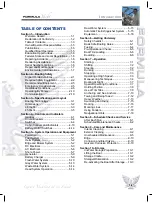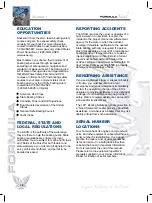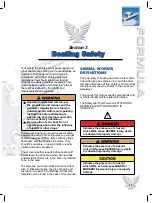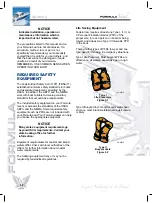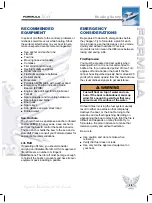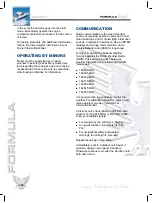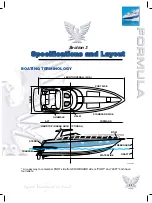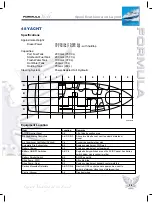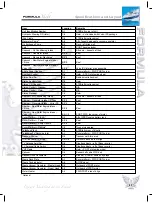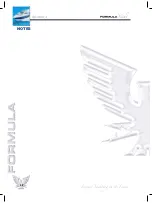
Flooding/Swamping
Improper loading, handling, water conditions,
weather and anchoring are the most common
causes of flooding. Insist on a safe, stable load.
Do not operate the boat exceeding your ability to
maneuver it. Use extreme caution in hazardous
weather and rough water conditions. Anchor
from the bow when using one anchor.
Collisions/Leaks
If a collision occurs, immediately account for all
passengers. Assess the hull for damage and
activate the bilge pumps to reduce any water
intake. Try to operate the boat to keep the
damaged area above water. If necessary, call or
signal for assistance.
If a leak is discovered, immediately determine
the cause. A collision with an underwater object
could cause the hull to develop a leak. A loose
fitting or hose clamp on a piece of equipment
could cause a leak. Try to repair the leak if
possible. If a leak is threatening the safety of you
and your passengers, call or signal for
assistance.
Grounding
In the event you run aground, assess the
situation before proceeding. Immediately stop
any water from entering the boat. Inspect the
propulsion units, steering and control systems,
and the hull for damage. Maneuver the boat to
safe water only if the hull and all operating
systems are in satisfactory operating condition.
Otherwise, call or signal for assistance.
Water Rescue (Man Overboard)
Immediately react to a person who has fallen
overboard. Keep the victim constantly in your
sight. Safely return to the victim as soon as
possible. Throw the person a life preserver. Turn
off the engines and help the person into the
boat.
Medical Emergency
Be prepared in the event of an emergency. Know
how to use your first aid kit. Be aware of any
special medical conditions of your passengers.
Drowning
React to a drowning victim the same as
described in Water Rescue. Handle the victim
with care. They could be injured. If necessary,
resuscitate the victim. Immediately signal for
help and keep the victim warm.
Operation Failure
If you experience a propulsion, steering or
control failure, immediately turn off the engines.
Set the anchor if possible or release a sea
anchor to prevent drifting. Try to determine the
failure and repair, if possible. Otherwise, call or
signal for assistance.
HAZARDOUS CONDITIONS
Every waterway poses hazards that you should
avoid, such as shallow water, tree stumps and
sand bars. Ask local boaters for information and
consult a marine chart when boating on
unfamiliar waters. As the operator of the boat,
you should try to avoid all hazards, known and
unknown. The following information does not
contain all possible water hazards.
Operating in shallow water presents a number of
hazards. Mud, sand, weeds and debris can foul
a propulsion unit propeller or its cooling water. If
a propulsion unit strikes an underwater object,
check the propulsion unit and boat for damage. If
a vibration is noticed after striking an object, it
may indicate a damaged propeller.
Sand bars in narrow inlets are constantly
shifting, making it difficult to mark them with
buoys. Tides in coastal areas affect water levels
producing sand bars. Sometimes sand bars are
indicated by waves as they form into breakers
when passing over the sand bar. Refer to
Grounding
, in this section, if you run aground
on a sand bar.
The water level around a dam spillway is a
hazardous area. It is subject to rapid changes
caused by currents and turbulence. Keep clear
of the spillway areas below dams.
2-6
Section 2
Summary of Contents for 48 2008
Page 28: ...NOTES 3 8 Section 3...
Page 70: ...NOTES 5 28 Section 5...
Page 82: ...Close Quarter Turns Figure 7 4 TWIN ENGINE MANEUVERING 7 6 Section 7 KC 1521...
Page 118: ...NOTES 10 4 Section 10...
Page 122: ...NOTES 11 4 Section 11...
Page 126: ...NOTES 12 4 Section 12...
Page 127: ...13 1 SERVICE LOG Date Hour Reading Service Repairs Performed Section 13 Forms...
Page 128: ...FUEL LOG Date Gallons Date Gallons Date Gallons Date Gallons 13 2 Section 13...
Page 132: ...NOTES 13 6 Section 13...



